Network theory miscellaneous
- For the given network, the current I is—

-
View Hint View Answer Discuss in Forum
The given circuit:
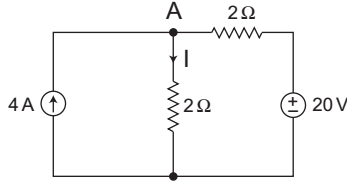
KCL at node A4 = VA + VA - 20 2 2
roVA + VA = 4 + 10 2 2
or
VA = 14V
Now,I = VA + 14 = 7A 2 2 Correct Option: C
The given circuit:

KCL at node A4 = VA + VA - 20 2 2
roVA + VA = 4 + 10 2 2
or
VA = 14V
Now,I = VA + 14 = 7A 2 2
- Which one of the following parameters does not exist for the two-port network shown in the given figure—
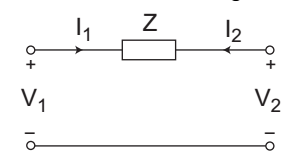
-
View Hint View Answer Discuss in Forum
The Z-parameters does not exist for the given twoport network.
Correct Option: D
The Z-parameters does not exist for the given twoport network.
- The two electrical subnetworks N1 and N2 are connected through three resistors as shown below. The voltage across the 5Ω resistor and the 1Ω resistor are given to be 10V and 5V respectively. The voltage across the 15Ω resistor is—
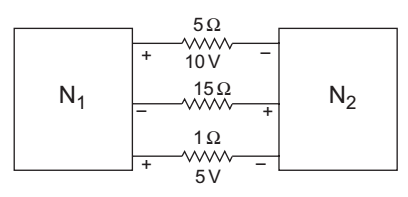
-
View Hint View Answer Discuss in Forum
The given circuit
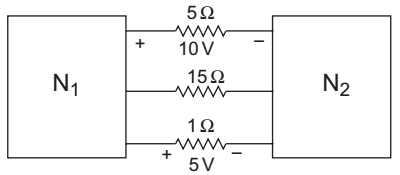
Current in 5Ω resistorl1 = 10 = 2A(From N1 to N2) 5
Current in 1Ω resistor
I2 = 5/1 = 5A (From N1 to N2)
The current in 15Ω resistor must be = 2 + 5 = 7A (from N2 to N1)
The voltage across 15Ω resistor = – 15 × 7V = – 105V.Correct Option: A
The given circuit

Current in 5Ω resistorl1 = 10 = 2A(From N1 to N2) 5
Current in 1Ω resistor
I2 = 5/1 = 5A (From N1 to N2)
The current in 15Ω resistor must be = 2 + 5 = 7A (from N2 to N1)
The voltage across 15Ω resistor = – 15 × 7V = – 105V.
- The average power delivered by the 500 ∠ 0° voltage source and dependent source for the circuit shown below—

-
View Hint View Answer Discuss in Forum
The given circuit:
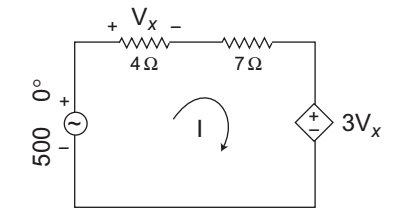
From given circuit 5
00 0° – 4I – 7I – 3Vx = 0 . . . . …(i)
and
Vx = 4I . . . . …(ii)
From equation (i) and (ii) 500 0° – 11I – 3Vx = 0
or 500 – 11I – 3 × 4 I= 0
orI = 500 0° = 21·73 0° 23
Now, the power delivered by the 500 0° voltage source =
1/2 VI= 1 × 500 0°× 21·73 2
= 5·432kW
The power delivered by the independent voltage source= 1 3Vx × I = 1 × 3 × 4I × I 2 2
= 6I2 = 6 (21·73)2
= 2·833 kW
Since the current I entering therefore power delivered will be negative i.e. – 2·833 kW.
Hence alternative (A) is the correct choice.Correct Option: A
The given circuit:

From given circuit 5
00 0° – 4I – 7I – 3Vx = 0 . . . . …(i)
and
Vx = 4I . . . . …(ii)
From equation (i) and (ii) 500 0° – 11I – 3Vx = 0
or 500 – 11I – 3 × 4 I= 0
orI = 500 0° = 21·73 0° 23
Now, the power delivered by the 500 0° voltage source =
1/2 VI= 1 × 500 0°× 21·73 2
= 5·432kW
The power delivered by the independent voltage source= 1 3Vx × I = 1 × 3 × 4I × I 2 2
= 6I2 = 6 (21·73)2
= 2·833 kW
Since the current I entering therefore power delivered will be negative i.e. – 2·833 kW.
Hence alternative (A) is the correct choice.
- In the circuit shown below, viewed from AB, the circuit can be reduced to an equivalent circuit as—

-
View Hint View Answer Discuss in Forum
The given circuit:
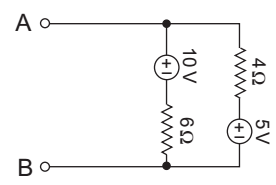
Equivalent circuit for Rth
From figure, Rth = 4|| 6 = 2·4Ω
Vth = 10 – 6 I
where,l = 10 - 5 = 5 = 0.5A 6 + 4 10
Now,
Vth = 10 – 6 × 0·5 = 10 – 3 = 7VCorrect Option: B
The given circuit:

Equivalent circuit for Rth
From figure, Rth = 4|| 6 = 2·4Ω
Vth = 10 – 6 I
where,l = 10 - 5 = 5 = 0.5A 6 + 4 10
Now,
Vth = 10 – 6 × 0·5 = 10 – 3 = 7V

